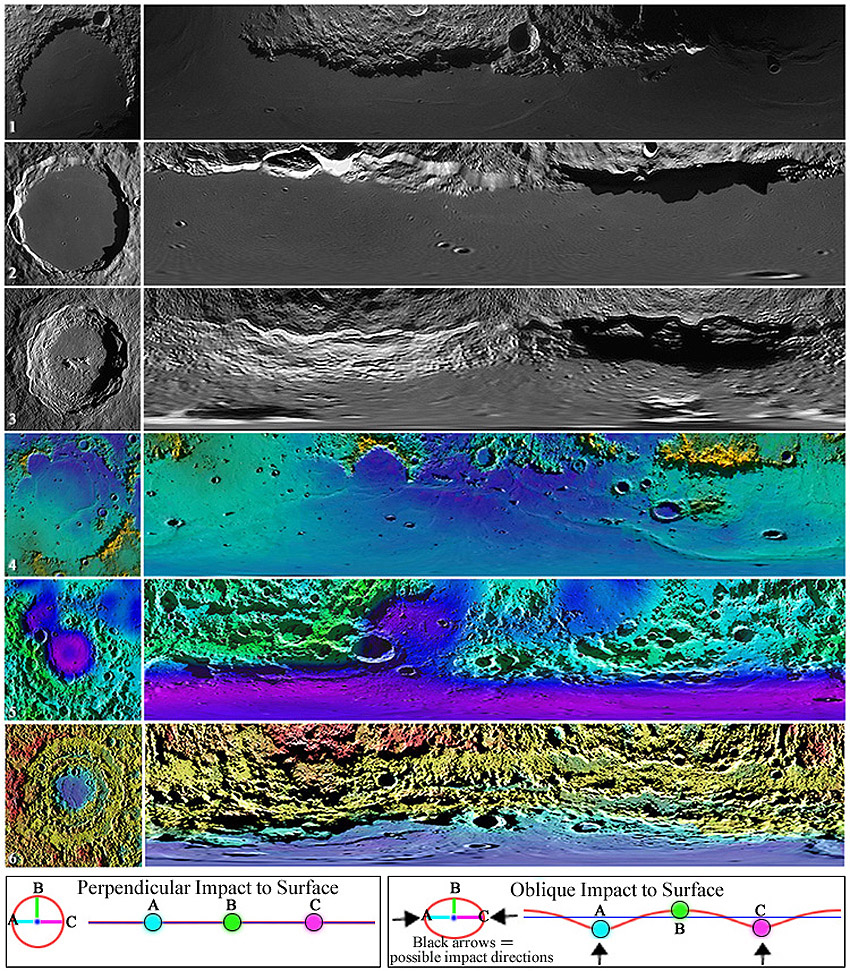Difference between revisions of "October 24, 2019"
(Created page with "__NOTOC__ =Straightening the Circle= Originally published June 12, 2010 <!-- Start of content --> <!-- ws:start:WikiTextHeadingRule:1:<h1> --> <!-- ws:start:WikiTex...") |
(No difference)
|
Latest revision as of 01:05, 24 October 2019
Straightening the Circle
Originally published June 12, 2010

image by John Moore, Ireland
Here are a few familiar views made unfamiliar using just a simple 'polar to rectangular' conversion (of the originals to the left). The top three show three craters that we're all used to seeing on LPOD, while the bottom three are recognisable maria. From most of the converted images, it can be seen how areas around the rim-floor, mountain-mare regions differ as a whole from, say, an imaginary straight line if drawn horizontally across them. While this conversion method of straightening circular features, like craters and maria, is just an experiment to see how they would look, I wonder if it would also have any application in the determination of impact-direction? As, is known, in some features the impact-direction can be determined by characteristic signatures, such as, the asymmetric appearance of craters e.g. Messier and Messier A, or the butterfly ray-pattern of, say, Proclus. However, while some features may look roundish when, in fact, they may not be as they may have slumping in their rims or missing serious gaps in their mountains/massifs etc., the detection of possible impact-directionality (if any should exists at all) would be hard. Might this method, therefore, be a way of measuring such events from this converted perspective? All one does is draw the above-mentioned, imaginary line across the full length of the straighened-out rim-floor, mountain-mare part, to see how it deviates above or below it. So, for example, if the impactor struck the surface mostly perpendicularly, the deviation from linearity wouldn't be that much, however, if it struck obliquely, it would be different - taking on a more wavey form (see bottom graphic). All that said, the above method may not be of any scientific use, and I am sure it has been well thought of before as a means for impact-direction, however, it still is an unusual way to 'see' features in this way.
John Moore
Technical Details
Features shown: (1) Sinus Iridum (Photo - Paolo R Lazzarotti). (2) Plato (Photo - Damian Peach). (3) Copernicus (Photo - Stefan Lammel). (4) Mare Imbrium (Selene Crustal Topo overlay on LDEM 64 - generated by LTVT). (5) Mare Nectaris (Selene Crustal Topo overlay on LDEM 64 - generated by LTVT). (6) Mare Orientale (LOLA overlay on LDEM 64 - generated by LTVT).
Photoshop (Filter/Distort/Polar Coordinates).
Yesterday's LPOD: A Hole with No Sides?
Tomorrow's LPOD: Capelling Gash
COMMENTS?
Register, Log in, and join in the comments.



